Witch hazel, a large deciduous shrub with forked branches and spider-like flowers, provides dazzling foliage in fall and brightly colored flowers to wintery landscapes.
This colorful plant has enjoyed a “colorful” history over the centuries. Native Americans boiled the bark and leaves of common witch hazel (Hamamelis virginiana) for medicinal purposes.
Witch hazel water was used as an astringent to reduce irritation and treat bug bites. Poultices of fresh leaves and bark were used to reduce inflammation. Witch hazel teas were used to treat dysentery, coughs and colds.
Some colonists even used the pliable crooked branches of witch hazel for “witching sticks” to search for underground water sources.
Growing witch hazel in the garden is easy as this plant is very adaptable. It grows naturally in partial or light shade but can tolerate full sun in the Northwest, and likes a moist, well-drained acid soil.
There are several species in the witch hazel family, including the Eastern North American native Hamamelis virginiana, the Chinese Hamamelis mollis, and the Japanese Hamamelis japonica.
H. virginiana is a large shrub growing to 20 feet in height. Its leaves are oval and dark green from above and paler beneath. In fall, the leaves turn yellow with rusty spots.
Typically more shrub-like than tree-like, H. japonica can grow to 12-20 feet tall and broad. Its fall foliage is dazzling in shades of red, yellow and purple.
H. mollis is typically 8-12 feet tall and wide, but can reach tree-like heights of 25 feet. Its leaves are rounder than H. virginiana or H. japonica, 3-6 inches long, dark green above with grey felted undersides. In the fall its foliage turns pure yellow.
Hamamelis x intermedia is a popular hybrid of H. japonica and H. mollis with a height and breadth somewhere in between the two. Varieties of H. x intermedia offer a wide range of flower and fall foliage colors.
Popular varieties include ‘Jelena’ (orange), ‘Diane’ (red to copper-red), ‘Orange Beauty’ (orange, yellow-orange), ‘Primavera’ (yellow), ‘Ruby Glow’ (red-orange) and ‘Arnold’s Promise’ (yellow). Visit your local nursery to find which varieties are available locally.
H. x intermedia is often grafted, so suckers growing beneath the graft should be removed. All other pruning should be limited to removing broken, diseased or poorly placed branches and those occasional flowering stems taken for bouquets.
In addition to planting witch hazel directly into the landscape, it can be successfully grown in a large container right outside your front door or on a deck where it is in full view.
As with most plants grown in containers, witch hazel will be smaller in size when grown in a container than when it is grown directly in the landscape.
Wherever you plant your witch hazel, consider adding outdoor lighting around your witch hazel to show off its color and to emphasize its crooked branching.
Wherever you choose to locate your witch hazel, its bright fall foliage and spidery winter flowers are sure to attract attention and add personality to your landscape.
Judy English is a WSU-certified WSU Clallam County Master Gardener.



